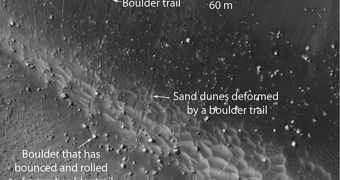The fact that Mars was geologically active in the distant past is no secret to anyone. In fact, all rocky planets in our solar system probably were. But the latest data sent back by a NASA spacecraft indicate that quakes occurred on the Red Planet only a few million years ago.
This came as a surprise to experts analyzing data from the NASA Mars Reconnaissance Orbiter's (MRO) High Resolution Imaging Science Experiment (HiRISE) instrument. The information seems to suggest that quakes occurred on our neighboring planet long after the planet was supposed to have ceased all activities.
On our planet, earthquakes are the direct result of active plate tectonics, which itself is the byproduct of an active, spinning planetary core. On Mars, tectonics are thought to have subdued billions of years ago. None of the probes humans ever sent there returned data to suggest otherwise.
Yet, the fact remains that geological features on its surface tell a different tale. Data from HiRISE can be trusted beyond question, since this is the most advanced camera ever sent to image another world.
If marsquakes indeed occurred recently, then the implications are astounding. This discovery could mean that active volcanism still occurs on the surface, which further implies that the planet may still be capable of producing liquid water.
The recent investigation focused on boulders in Cerberus Fossae, a renowned fault system that passes right through a relatively young lava flow. Due to its amazing power, HiRISE was able to provide high-resolution imagery of patterns left on the ground by boulders that fell from the walls of fault system.
By comparing these marks with similar traces produced by boulders here on Earth, the team was able to demonstrate that tectonic activity indeed caused the rocks to tumble from their previous locations.
In addition, glaciologists confirmed that the patterns in which the boulders are deposited on the surface of the lava flow are not consistent with those seen on Earth, when advancing glaciers move rocks.
“This is consistent with the hypothesis that boulders had been mobilized by ground-shaking, and that the severity of the ground-shaking decreased away from the epicenters of marsquakes,” University of London earthquake geologist Gerald Roberts explains.
Details of the study by Roberts and his colleagues will be published in the February 23 issue of the esteemed Journal of Geophysical Research-Planets, SpaceRef reports.

 14 DAY TRIAL //
14 DAY TRIAL //